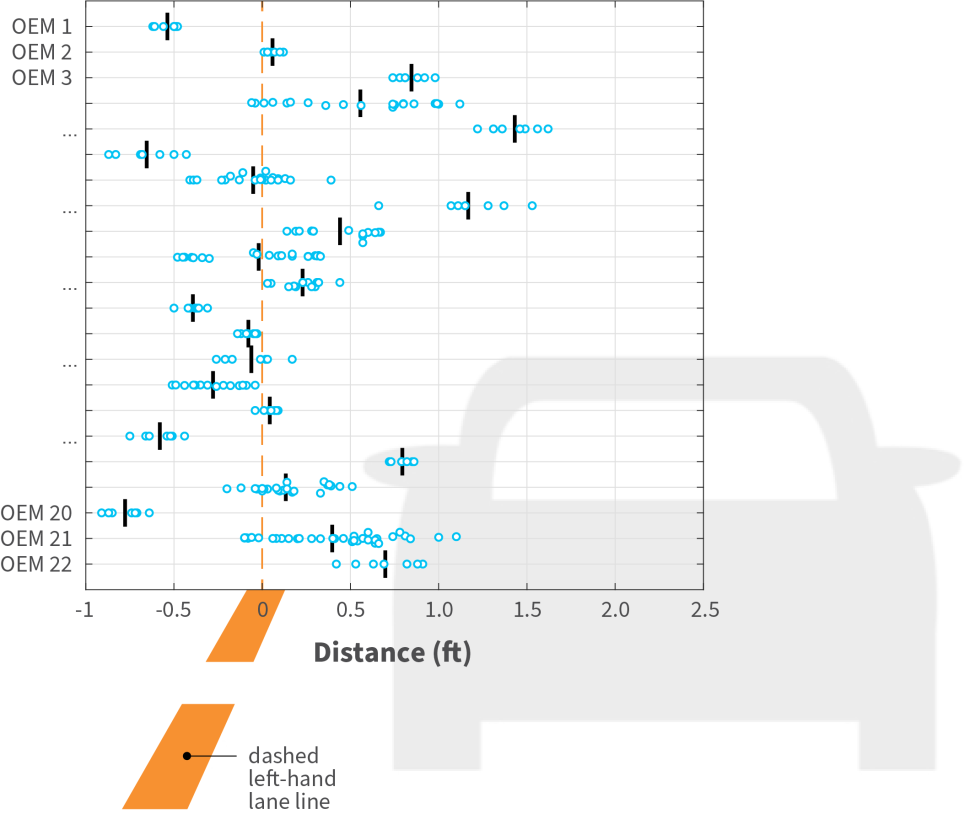March 13, 2023
Identifying limitations of complex software and hardware with multidisciplinary, specialized testing
Advanced driver assistance systems (ADAS) have been introduced at an accelerated pace over the past two decades, with an overarching objective of reducing the risks associated with road collisions caused by human error. This wide array of features can provide warnings, alerts, momentary and continuous assistance, or emergency safety interventions.
ADAS technologies and related regulatory developments are evolving so quickly that it can be difficult for consumers to understand the limitations of these complex systems. Significantly, ADAS features require constant driver supervision and are not fully automated technologies that function without human intervention. The driver retains full responsibility for operating an ADAS-equipped vehicle. Likewise, no ADAS feature is fully effective under all circumstances, and performance can vary substantially by manufacturer or developer.
Advancements in software and hardware are quickly converging to foster an even more rapid evolution for ADAS features.
As vehicle manufacturers and regulators navigate the proliferation of complex new technologies, a focus on consumer education and specialized, highly repeatable testing is integral for the entire product journey — from design to deployment and use over time.
Supporting sophisticated integration of increasingly complex ADAS technologies
Innovation and technology for ADAS features are developing on a continuum. While software and hardware are constantly improving, these systems must be integrated in ever more sophisticated ways to maximize their potential safety benefits; the system performance of ADAS-equipped vehicles remains variable depending on design and manufacturer.
Early technologies like lane departure warnings (LDW) and forward collision warnings (FCW) focused on alerting drivers of potential hazards. Building on those initial efforts to reduce the prevalence of driver error, companies have moved on to automated functions in vehicles, such as adaptive cruise control (ACC), automatic emergency braking (AEB), and lane keeping assist (LKA). Advancements in software and hardware are quickly converging to foster an even more rapid evolution for ADAS features, along with their associated risks for manufacturers and consumers.
These advanced vehicle electronic systems rely on the interaction between a series of sensors, software, and electronics modules that include cascading functions such as:
- Sensors detect the surrounding environment in addition to the state of the vehicle, for example, objects in close proximity to the vehicle, relative speeds, braking and deceleration, and other variables;
- Software analyzes the environmental data observed by the sensors to enable system perception of both the vehicle and the world surrounding it;
- Electronic modules generate warnings, apply emergency braking, adjust steering position, deploy airbags, and perform other automotive functions like throttle control and battery charging.
Emerging technologies are currently in development, including innovations in vehicle-to-vehicle and vehicle-to-infrastructure communications, both of which are commonly associated with the notion of "connected vehicles" (vehicles that interact with one another in addition to their surrounding environment). Even more advanced capabilities, such as vehicle-to-pedestrian communications, could be introduced in the near future, with continuous improvements to already-existing radar, camera, lidar, and sensor technologies.
However, successfully integrating these features requires a multidisciplinary approach. Manufacturers typically consider numerous factors including technological advancements, software capabilities, and human factors, which studies the expected interactions between drivers and ADAS-equipped vehicles.
Assessing the current and future regulatory landscape for ADAS-equipped vehicles
Industry classifies the degrees of advanced driver support and automation features a vehicle offers according to the SAE standard J3016, Levels of Driving Automation™, which range from Level 0 (no driving automation) to Level 5 (full driving automation).
Existing ADAS technologies are categorized as Level 0-2, providing warnings, momentary assistance, or extra support with steering, braking, or acceleration. When these ADAS features are engaged, the driver must remain in total control of their vehicle.
Just as integrating complex ADAS features demands a multidisciplinary approach, testing must also evolve to encompass a wider scope that keeps pace with ongoing technological and regulatory changes.
For consumers, as these technologies continue to evolve, the distinction between Level 2 driver support features and Level 3 automated driving features might not always be clear. A Level 3 feature can drive the vehicle in certain conditions, but the driver must still be prepared to take control at any time. However, if a Level 0-2 feature is perceived as a Level 3, a driver may assume false confidence and less responsibility for their vehicle.
To help combat this and support consumer education, in 2022 the National Highway Transportation Safety Administration (NHTSA) announced a series of actions including revised guidelines and a campaign to improve public knowledge about potential safety benefits of ADAS features and help distinguish Levels of Driving Automation™.
Evaluating variability and limits of complex ADAS features with reproducible testing
As ADAS technologies increase in both number and complexity in the coming years, so will the vital role of reproducible testing for reliability and performance of ADAS-equipped vehicles. Modern, specialized testing not only informs the design and development of these systems but also provides a detailed analysis to identify design, operational, or user conditions that may have contributed to a failure. Thoroughly testing the limits and measuring the effectiveness of these emerging technologies is an essential component to creating a safer future on the road.
Just as integrating complex ADAS features demands a multidisciplinary approach, testing must also evolve to encompass a wider scope that keeps pace with ongoing technological and regulatory changes. Rather than regulating a safety feature based on whether it activates five out of seven times, for example, a more robust testing model will assess performance against myriad factors such as time of day, weather and sunlight conditions, driver distractions, and other customizable options at various speeds to bolster understanding of limitations and identify variabilities in ADAS support features.

These variabilities are demonstrated with specialized, reproducible testing scenarios. Testing ADAS features like lane departure warnings across various manufacturers (Figure 1) not only shows how the performance of this technology has evolved over time but creates a clear picture of the significant variation of performance in specific features per manufacturer. For example, because there is no regulatory mandate dictating that a lane departure warning activation must occur at some predefined distance from a lane line such as 1 foot, some manufacturers have elected to implement warnings at different vehicle drift distances from, or beyond, an inadvertently crossed lane line. These types of ADAS features will, by design, perform differently under very similar situations due to different performance design goals and technological implementations, including preventing nuisance alerts that may ultimately cause a driver to disable the ADAS feature.
Leveraging the next generation of ADAS performance testing and failure analysis
ADAS features are subject to a variety of limitations and variabilities. As existing technologies are refined and new capabilities introduced, sophisticated testing and multidisciplinary analysis can help drivers and manufacturers alike make the most of them.
Navigating the continuous process of technological and regulatory development in complex driver support systems is a growing challenge that can be supported by next-generation testing.
What Can We Help You Solve?
Exponent is well-versed in assessing performance against various metrics for specific advanced driver assistance systems (ADAS) applications and providing customized testing to clients as their needs evolve. Our consultants actively investigating both the present-day performance and future evolution of these systems, both during development and when equipped vehicles are involved in accidents.

Sensor & Sensor Systems
Expert support for all areas of integrated sensor system design and analysis.

Vehicle Electronics & Electrical Systems
Increase the viability of your ADAS applications with optimal design and function.
![COMPUTER SYSTEMS & CONTROLS [EECS]](/sites/default/files/styles/cards_home_card/public/media/images/GettyImages-1352474775.jpg?itok=3_nh-Rmg)
Instrumentation & Control Systems
Improve the reliability and performance of control systems and their sensors, processors, actuators, and logic.

Accident Reconstruction & Analysis
Crash analysis and transportation accident investigation and reconstruction services.



